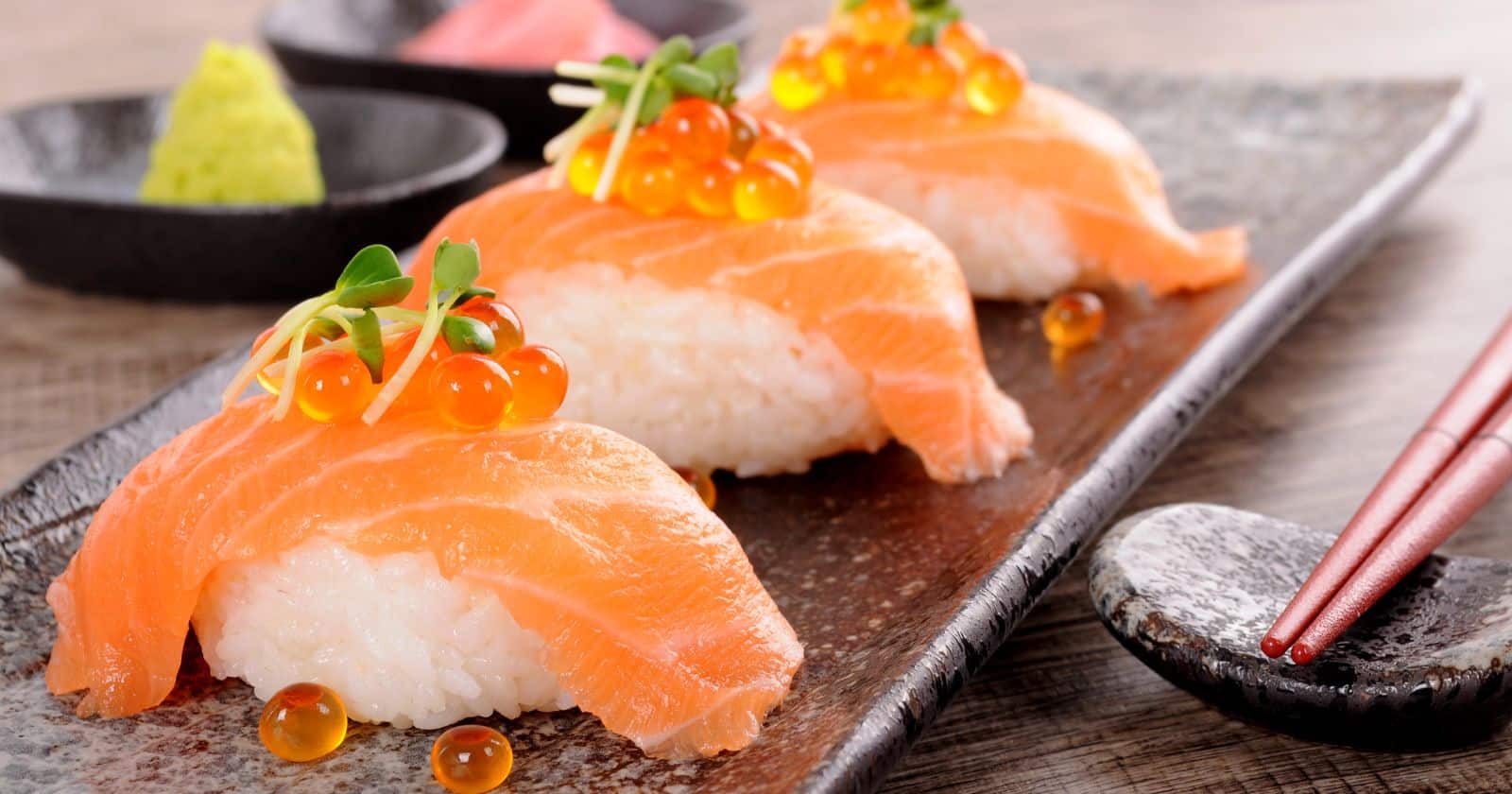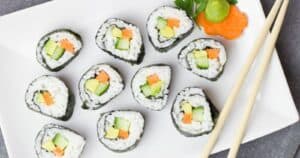Hey sushi lovers! Have you ever wondered what type of salmon is best for sushi? When it comes to salmon sushi, the most commonly used fish is wild-caught Sockeye salmon, also called Red or Blueback salmon. This bright orange-fleshed fish is prized for its firm, rich texture and full flavor. However, King, Coho, and Chum salmon can also be used to make delicious sushi rolls and nigiri.
The key is choosing high-quality, sushi-grade salmon. This means the salmon was handled with care when caught and immediately flash-frozen to kill bacteria and parasites. When buying salmon for sushi, look for fish with vibrant color, minimal dark spots or discoloration, and firm flesh. Be sure to freeze the salmon for at least 7 days before thawing and eating to further protect against illness.
Curious to learn more about sushi salmon? In this article, we’ll dive into the differences between salmon types, what makes it sushi-grade, and tips for choosing and preparing salmon sushi at home. We’ll even share a couple mouthwatering sushi recipes featuring sockeye and king salmon. Let’s get rolling!
The Most Common Salmon Varieties for Sushi
Sockeye salmon reigns supreme when it comes to salmon sushi. Also known as red or blueback salmon, this fish has vibrant orange-red flesh that’s treasured for its velvety texture and rich, fatty taste. Of all salmon types, sockeye has the highest oil content, making it a luxurious choice for sushi rolls, nigiri, and sashimi.
Other good options include:
- King salmon: Prized for its high fat content and delicate flavor. The flesh ranges from white to deep orange-red.
- Coho salmon: Leaner with a mellow taste. The pink to orange meat has a moderately firm texture.
- Chum salmon: Lower in fat with a mild flavor. The light pink or orange flesh is moist and tender when fresh.
While any wild-caught salmon can be used for sushi, sockeye remains the top choice among sushi chefs and fans.
What Makes Salmon “Sushi-Grade”
You’ll often see the term “sushi-grade” used to describe premium salmon for sushi. But what makes salmon sushi-grade? Here are the key factors:
- Handling – Sushi-grade salmon is processed with care right after being caught. It’s immediately gutted, cleaned, and iced or flash-frozen to maintain freshness.
- Freshness – The fresher the salmon, the better the texture and flavor. Sushi-grade salmon is ultra-fresh, no more than a few days old.
- Fat content – Higher fat varieties like sockeye and king are ideal. The fat gives the salmon a silky texture.
- Freezing – Freezing salmon first kills any parasites or bacteria present. Sushi-grade salmon is frozen at -20°C (-4°F) or below for at least 7 days.
- No preservatives or additives – True sushi-grade salmon contains no preservatives, MSG or added water. It’s pure, all-natural salmon.
Buying reputable sushi-grade salmon is key for making sushi that’s delectable and safe to eat raw.
Choosing High-Quality Salmon for Sushi
When shopping for salmon, here are some tips for picking the best quality fish for sushi:
Check the color – Whole salmon should have shiny, metallic skin and deep, vibrant colored flesh. Dull or pale meat is a sign of age.
Give it a sniff – Fresh salmon has a mild, clean scent. Rancid or strong “fishy” odors mean the salmon is old.
Feel the firmness – Salmon flesh should spring back when pressed and feel firm, never mushy. Soft texture indicates spoilage.
Look for safe handling – Buy from reputable sellers and markets keeping salmon well-iced or frozen. Avoid salmon sitting in pools of melted ice water.
Get sushi cuts – Look for center-cut salmon blocks that are ideal for sashimi and sushi. The tail area tends to be fattier.
Check the price – Higher fat salmon like sockeye and king cost more. Price is a good indicator of quality.
Following these tips will help you pick out the best salmon fillets for rolling stunning sushi at home.
Preparing Salmon for Sushi
To kill any bacteria or parasites, salmon needs to be frozen before using it for sushi. Here are some freezing tips:
- Place salmon in freezer bags, removing excess air. Or wrap tightly in plastic wrap.
- Freeze at -20°C (-4°F) or below for at least 7 days. This kills parasites.
- Thaw in the fridge just before use. Defrost for 12-24 hrs depending on thickness.
Once thawed, you’ll also want to remove any tiny bones. Run your fingers along the salmon fillets to feel for bones. Use fish tweezers or needle-nose pliers to remove them. Rinse fillets under cold water and pat dry.
Finally, slice the salmon fillet into thin sashimi slices. A sharp sashimi knife makes clean cuts. Slice salmon across the grain on a slight diagonal. Slices should be 1⁄4 inch thick or less.
Now your fresh sushi-grade salmon is ready to be rolled into delectable sushi treats!
Sockeye Salmon Sushi Roll
Rich sockeye salmon is an absolute treasure for sushi. Try it in this easy California roll, one of our favorite salmon sushi recipes:
Ingredients:
- 1⁄2 cup sushi rice, cooked
- 3 sheets toasted nori
- 1 avocado, sliced
- 3 oz sushi-grade sockeye salmon, sliced thin
- 1 tsp sesame seeds
- Soy sauce for serving
Directions:
- Lay a nori sheet shiny-side down on a bamboo mat. Spread rice evenly over 2⁄3 of the sheet.
- Layer salmon, avocado slices, and sesame seeds over the rice.
- Roll up tightly using the mat. Cut roll into 6 pieces with a sharp knife.
- Repeat process with remaining ingredients. Serve with soy sauce for dipping.
The buttery avocado and rich sockeye salmon pair perfectly in this classic roll. Add a dollop of wasabi to kick it up a notch!
Spicy King Salmon Sushi Bowls
For a filling salmon sushi meal, try these spicy salmon bowls topped with creamy king salmon.
Ingredients:
- 3⁄4 cup sushi rice, cooked
- 1 king salmon fillet (6 oz), sliced thin
- 1 English cucumber, sliced
- 1 avocado, sliced
- 2 radishes, sliced
- 1 tsp sesame oil
- 1 Tbsp sriracha
- 2 Tbsp Japanese mayo
- 3 Nori sheets, crumbled
Directions:
- Divide sushi rice between two bowls. Arrange cucumber, avocado and radish slices artfully over rice.
- In a bowl, mix sesame oil, sriracha and mayo. Spoon over salmon slices.
- Top bowls with spicy salmon slices and sprinkle with crumbled nori.
The spicy mayo sauce gives the king salmon a kick. Mixing textures like creamy avocado, crisp cucumber and radish makes these bowls extra tasty.
Final Sushi Tips
While sockeye and king salmon are sushi all-stars, don’t be afraid to branch out. Coho, chum and Atlantic salmon all make great additions to sushi rolls.
No matter what type you use, be sure to start with high-quality sushi-grade salmon. Handle raw salmon safely, and choose salmon with vibrant color and firm texture. Portion salmon sushi within a couple days for best quality.
With so many ways to feature salmon’s luscious flavor in sushi, why limit yourself to just one variety? Experiment and see which types you like best when it comes to answering that key question – what salmon do you use for sushi?





